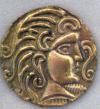Mars Soil Sample Delivered

The rover’s Chemistry and Mineralogy (CheMin) instrument is analyzing this sample to determine what minerals it contains.
Credit: NASA/JPL-Caltech
“We are crossing a significant threshold for this mission by using CheMin on its first sample,” said Curiosity’s project scientist, John Grotzinger of the California Institute of Technology in Pasadena. “This instrument gives us a more definitive mineral-identifying method than ever before used on Mars: X-ray diffraction. Confidently identifying minerals is important because minerals record the environmental conditions under which they form.”
The previous day, the rover shook the scooped material inside sample-processing chambers to scrub internal surfaces of any residue carried from Earth. One earlier scoopful was also used for cleaning. Additional repetitions of this cleaning method will be used before delivery of a future sample to the rover’s other internal analytic instrument, the Sample Analysis at Mars investigation, which studies samples’ chemistry.
This image shows part of the small pit or bite created when NASA’s Mars rover Curiosity collected its second scoop of Martian soil at a sandy patch called “Rocknest.” The bright particle near the center of this image, and similar ones elsewhere in the pit, prompted concern because a small, light-toned shred of debris from the spacecraft had been observed previously nearby (PIA16230). However, the mission’s science team assessed the bright particles in this scooped pit to be native Martian material rather than spacecraft debris.
Credit: Image credit: NASA/JPL-Caltech/MSSS
This image was taken by the Mars Hand Lens Imager (MAHLI) camera on Curiosity’s arm during the 69th Martian day, or sol, of the mission (Oct. 15, 2012), about a week after the scoop dug this hole. The view here covers an area of ground about 1.6 inches (4 centimeters) across.
Various small bits of light-toned material on the ground at Rocknest have affected the rover’s activities in the past several days. One piece about half an inch (1.3 centimeters) long was noticed on Oct. 7. The rover team postponed use of the robotic arm for two days while investigating this object, and assessed it to be debris from the spacecraft.
Images taken after Curiosity collected its second scoop of Rocknest material on Oct. 12 showed smaller bits of light-toned material in the hole dug by the scooping action. This led to discarding that scoopful rather than using it to scrub the processing mechanisms. Scientists assess these smaller, bright particles to be native Martian material, not from the spacecraft.
“We plan to learn more both about the spacecraft material and about the smaller, bright particles,” said Curiosity Project Manager Richard Cook of NASA’s Jet Propulsion Laboratory, Pasadena. “We will finish determining whether the spacecraft material warrants concern during future operations. The native Mars particles become fodder for the mission’s scientific studies.”
During a two-year prime mission, researchers are using Curiosity’s 10 instruments to assess whether the study area has ever offered environmental conditions favorable for microbial life. JPL, a division of Caltech, manages the project and built Curiosity. For more about Curiosity, visit: http://www.nasa.gov/msland http://mars.jpl.nasa.gov/msl .
Contacts and sources:
Guy Webster
Jet Propulsion Laboratory, Pasadena, Calif.
Anyone can join.
Anyone can contribute.
Anyone can become informed about their world.
"United We Stand" Click Here To Create Your Personal Citizen Journalist Account Today, Be Sure To Invite Your Friends.
Before It’s News® is a community of individuals who report on what’s going on around them, from all around the world. Anyone can join. Anyone can contribute. Anyone can become informed about their world. "United We Stand" Click Here To Create Your Personal Citizen Journalist Account Today, Be Sure To Invite Your Friends.
LION'S MANE PRODUCT
Try Our Lion’s Mane WHOLE MIND Nootropic Blend 60 Capsules
Mushrooms are having a moment. One fabulous fungus in particular, lion’s mane, may help improve memory, depression and anxiety symptoms. They are also an excellent source of nutrients that show promise as a therapy for dementia, and other neurodegenerative diseases. If you’re living with anxiety or depression, you may be curious about all the therapy options out there — including the natural ones.Our Lion’s Mane WHOLE MIND Nootropic Blend has been formulated to utilize the potency of Lion’s mane but also include the benefits of four other Highly Beneficial Mushrooms. Synergistically, they work together to Build your health through improving cognitive function and immunity regardless of your age. Our Nootropic not only improves your Cognitive Function and Activates your Immune System, but it benefits growth of Essential Gut Flora, further enhancing your Vitality.
Our Formula includes: Lion’s Mane Mushrooms which Increase Brain Power through nerve growth, lessen anxiety, reduce depression, and improve concentration. Its an excellent adaptogen, promotes sleep and improves immunity. Shiitake Mushrooms which Fight cancer cells and infectious disease, boost the immune system, promotes brain function, and serves as a source of B vitamins. Maitake Mushrooms which regulate blood sugar levels of diabetics, reduce hypertension and boosts the immune system. Reishi Mushrooms which Fight inflammation, liver disease, fatigue, tumor growth and cancer. They Improve skin disorders and soothes digestive problems, stomach ulcers and leaky gut syndrome. Chaga Mushrooms which have anti-aging effects, boost immune function, improve stamina and athletic performance, even act as a natural aphrodisiac, fighting diabetes and improving liver function. Try Our Lion’s Mane WHOLE MIND Nootropic Blend 60 Capsules Today. Be 100% Satisfied or Receive a Full Money Back Guarantee. Order Yours Today by Following This Link.






